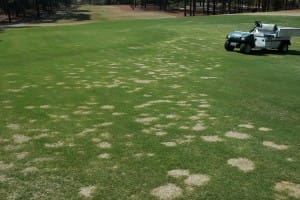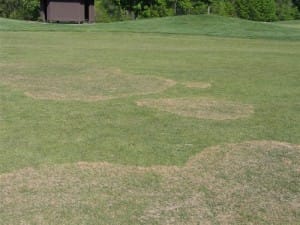Source(s):
- Lee Burpee, Plant Pathology Department, The University of Georgia.
- Alfredo Martinez-Espinoza, The University of Georgia.
“Large Patch” and “Spring Dead Spot” appear on turfgrass during spring green-up. While symptoms appear in the spring, truly effective disease management starts in the fall.


Large Patch
Rhizoctonia large patch is likely to develop on zoysia, centipede and St. Augustinegrass during cool, wet periods in spring. Zoysia is particularly affected. Look for yellow or straw-colored patches a few inches to 10 feet or more in diameter. Turfgrass shoots at perimeters of patches will have leaf sheaths that are dark brown to black. Lush, fertile turf is highly susceptible to Rhizoctonia; therefore, delay nitrogen applications until mid-May or later. Sound cultural practices help control the disease; therefore avoid frequent light irrigation to reduce humidity. Allow time during the day for plant canopy to dry. Increase air circulation. Shrub and tree barriers contribute to shade and lack of air circulation. Reduce thatch (no more than 1 inch thick).
Fungicides can be applied in the spring to aid in the control of the disease. Fungicides that contain azoxystrobin, flutolanil, and pyraclostrobin, have provided 28 days control of large patch in tests at UGA. Repeat applications may be required if night temperatures less than 55oF persist after the grasses come out of dormancy. However the most effective management of large patch occurs in the fall.
Spring Dead Spot
Spring dead spot is typically more damaging on intensively managed turfgrass (such as bermudagrass greens) compared to low maintenance areas. Initial symptoms appear in the spring, when turf resumes growth from its normal winter dormancy. As the turf ‘greens-up,’ circular patches of turf appear to remain dormant, roots, rhizomes and stolons are sparse and dark-colored (necrotic). No growth is observed within the patches.
Recovery from the disease is very slow. The turf in affected patches is often dead, therefore recovery occurs by spread of stolons inward into the patch. The disease is caused by several fungi in the genus Ophiosphaerella (O. korrae, O. herpotricha and O. narmari). These fungi infect roots in the fall, predisposing the turf to winter kill. Research shows that freezing temperatures make the disease worse.
Spring treatment consists of encouraging growth so that the stolons will move into the dead area. Implement regular schedules of dethatching and aerification. These activities encourage growth and will help to control the disease.
Fall application of fungicides is essential for an effective control. Currently, fenarimol, myclobutanil, azoxystrobin, thiophanate-methyl, and propiconazole are labeled for spring dead spot control. Management strategies that increase bermudagrass cold tolerance such as applications of potassium in the fall prior to dormancy are thought to aid in disease management. However, researchers have recently found that fall applications of potassium at high rates actually increased spring dead spot incidence. Therefore, application of excessive amounts of potassium or other nutrients, beyond what is required for optimal bermudagrass growth, is not recommended.
Resource(s):
- Brown Patch and Pythium Blight - July 22, 2018
- Gray Leaf Spot - July 22, 2018
- Gray Leaf Spot in Turf - September 24, 2013